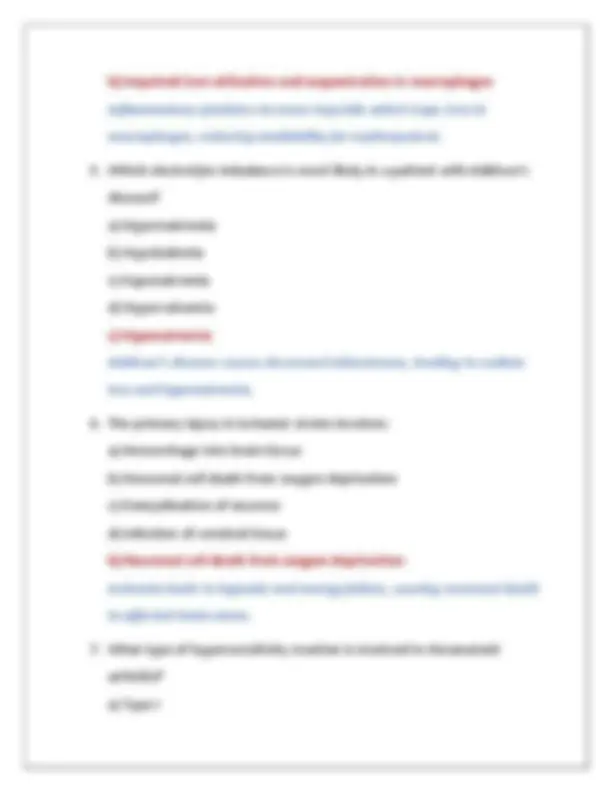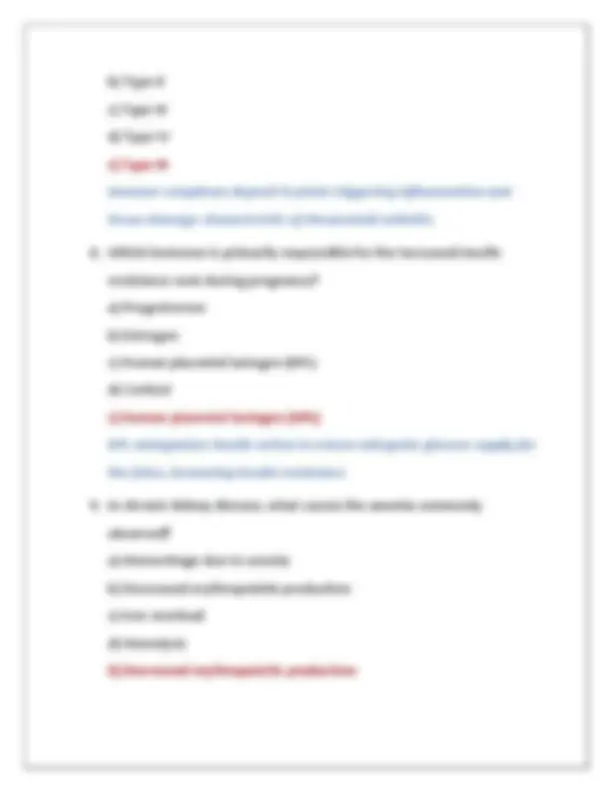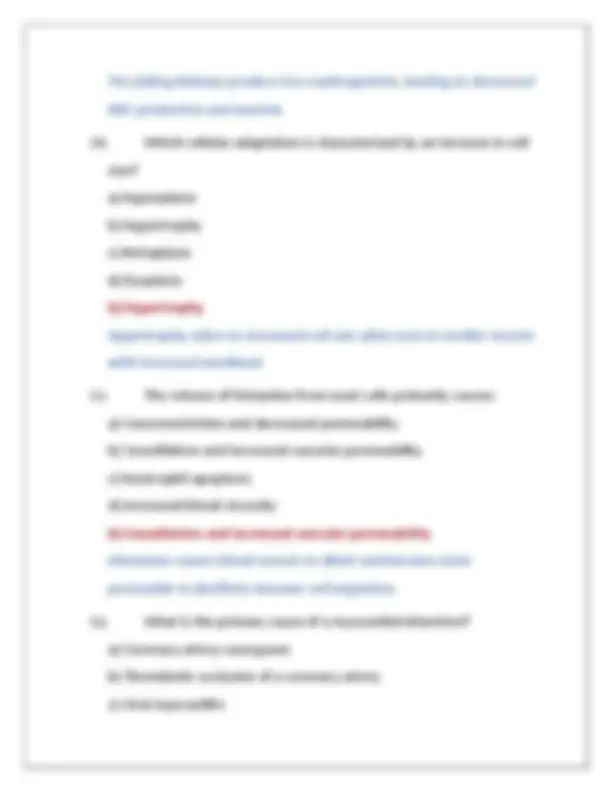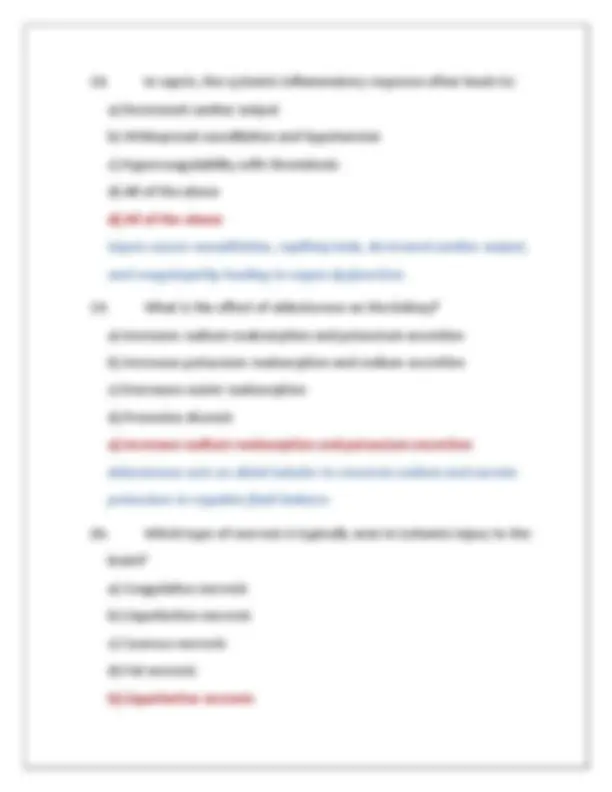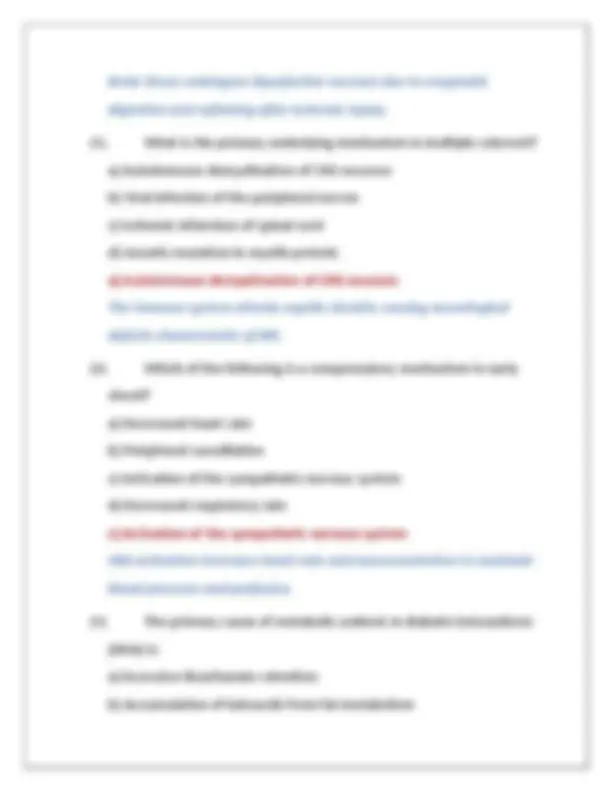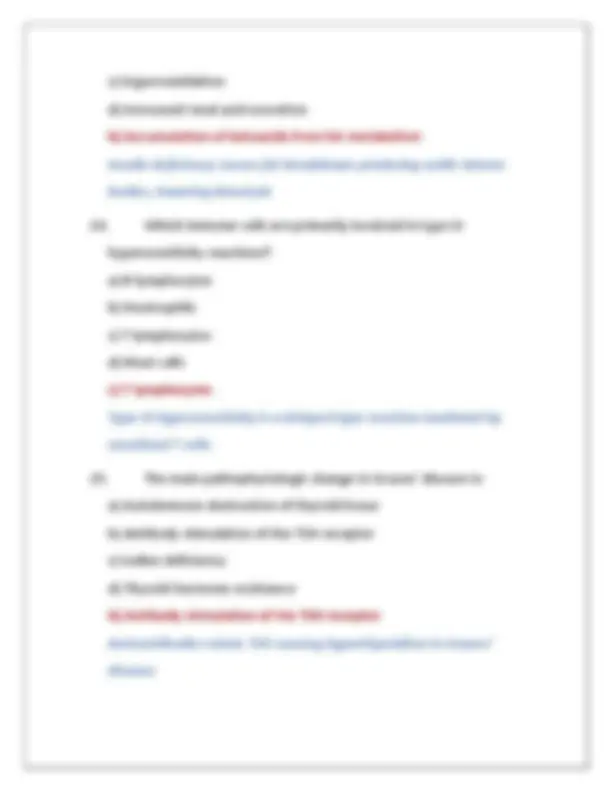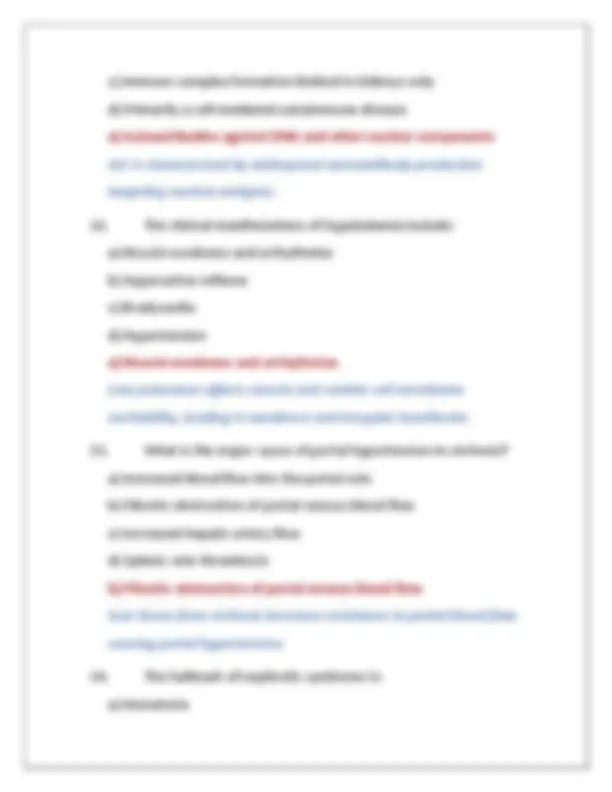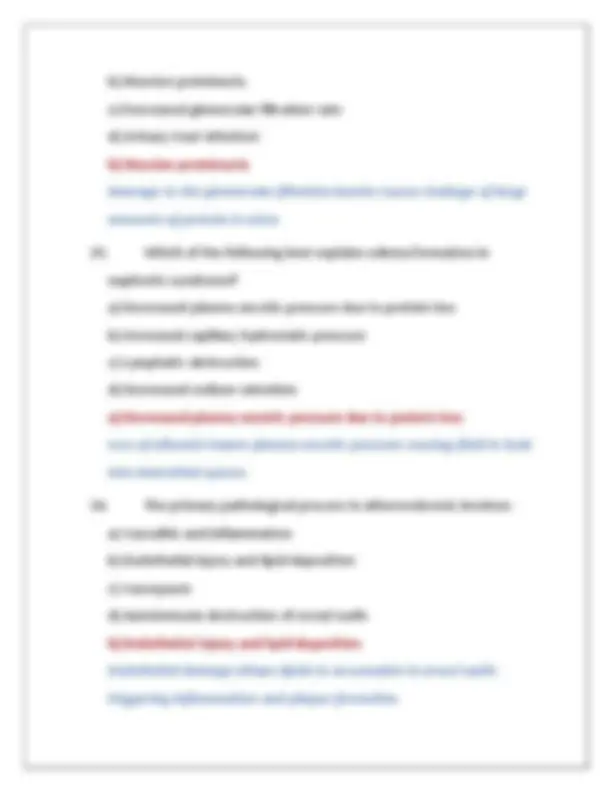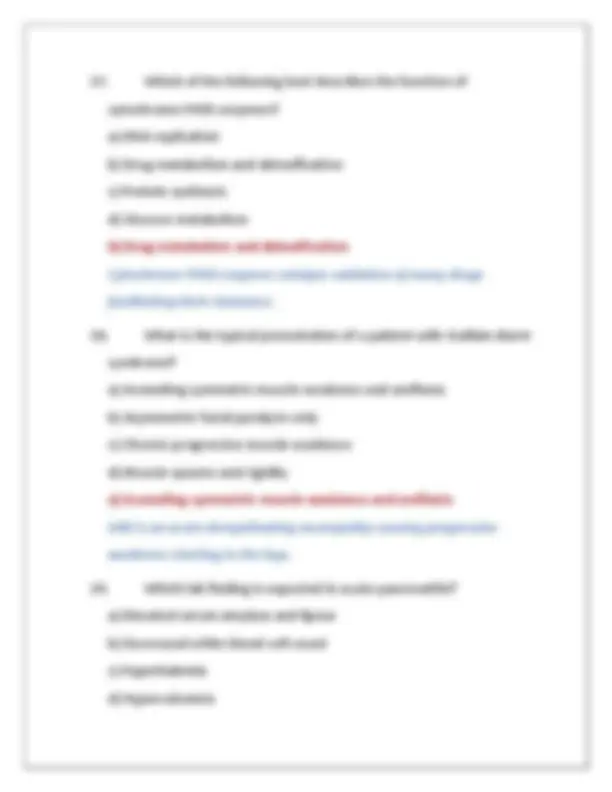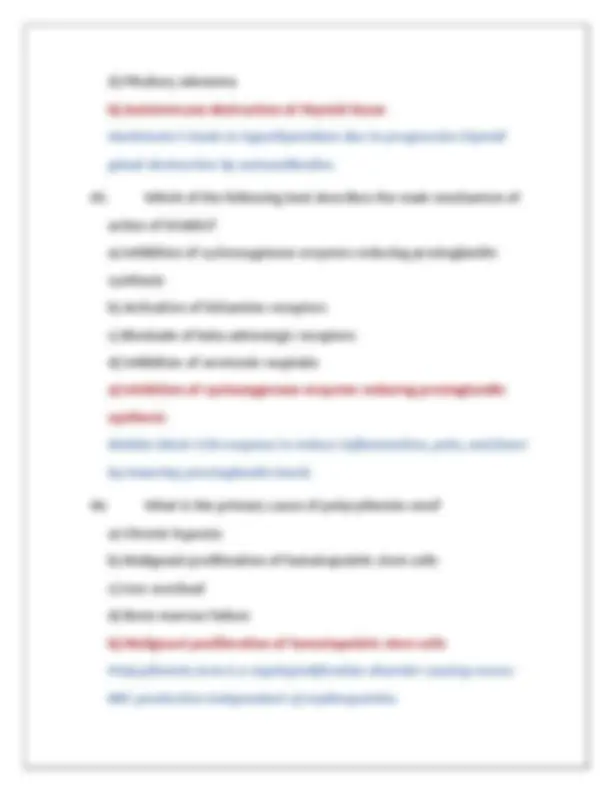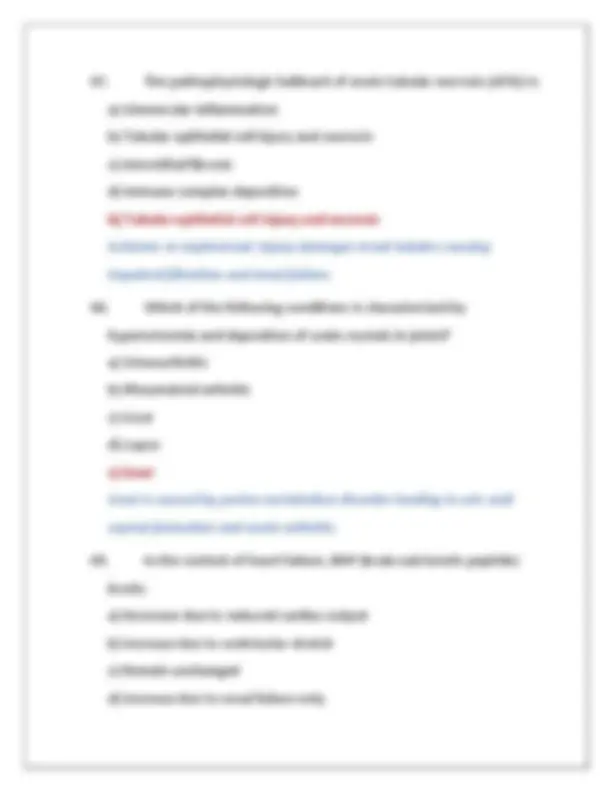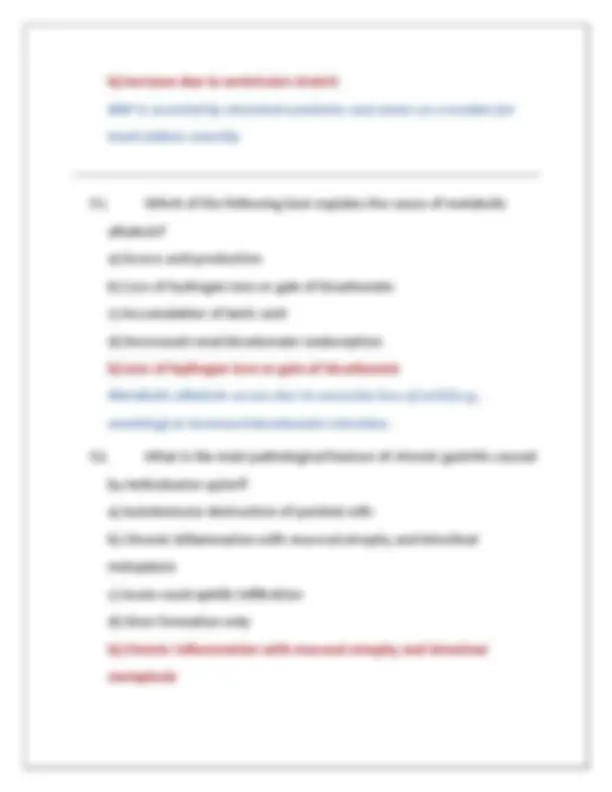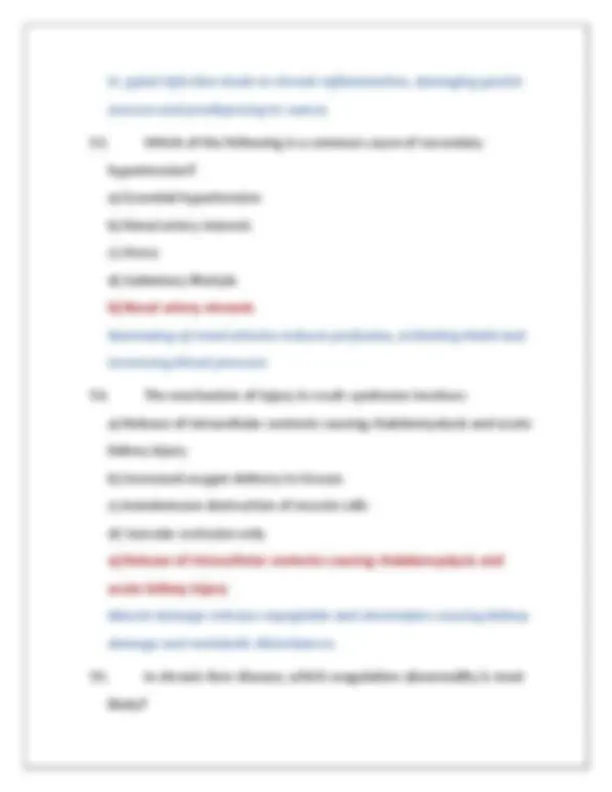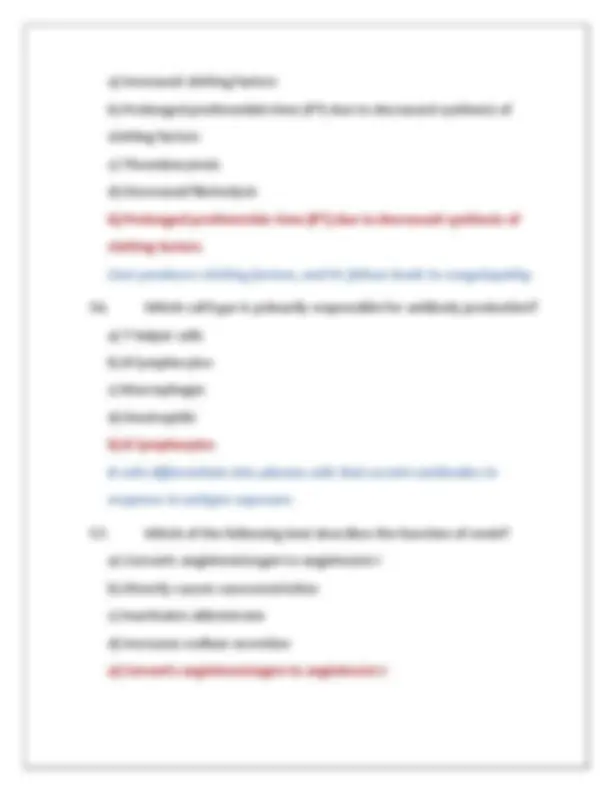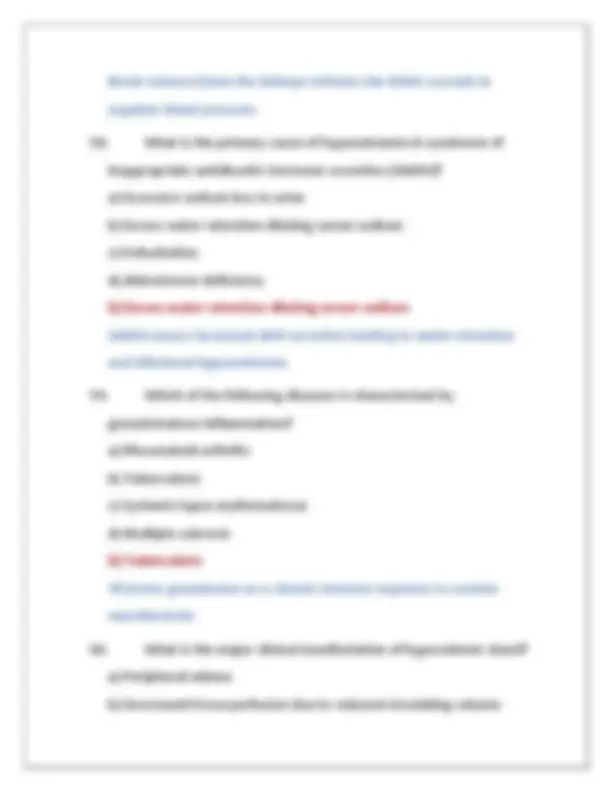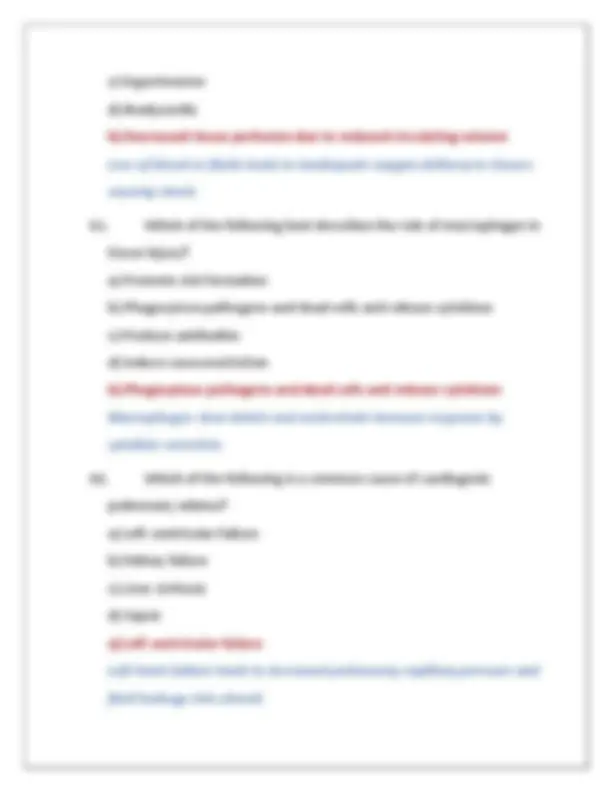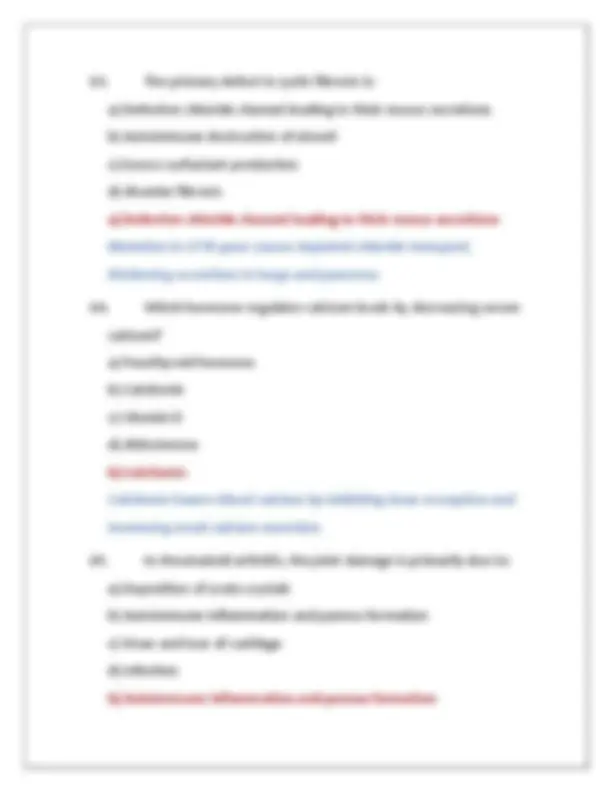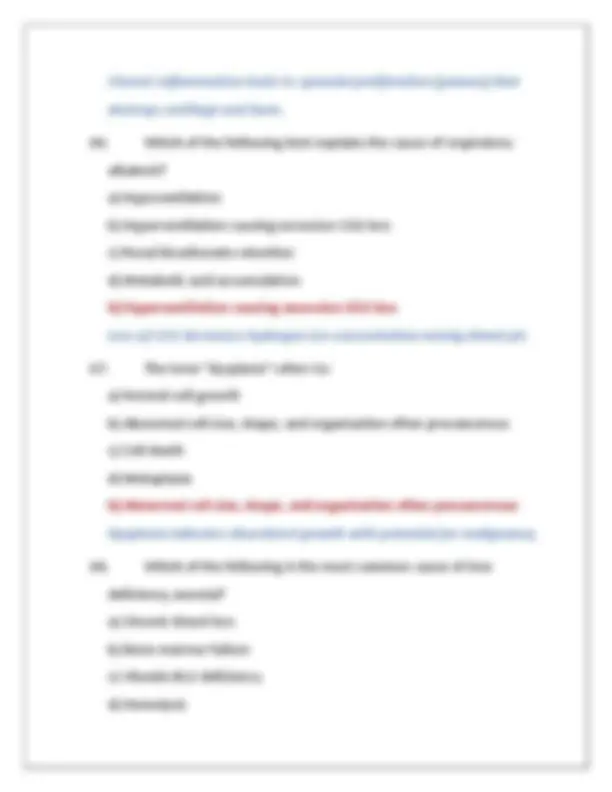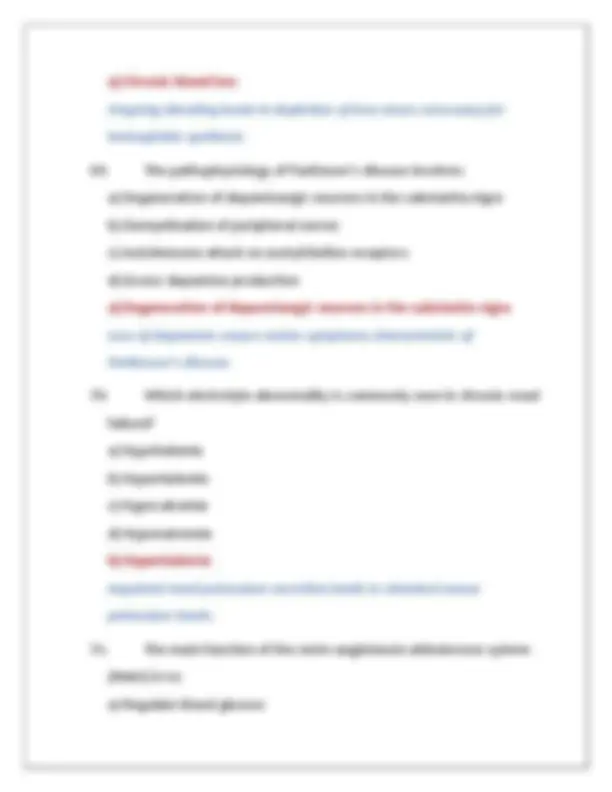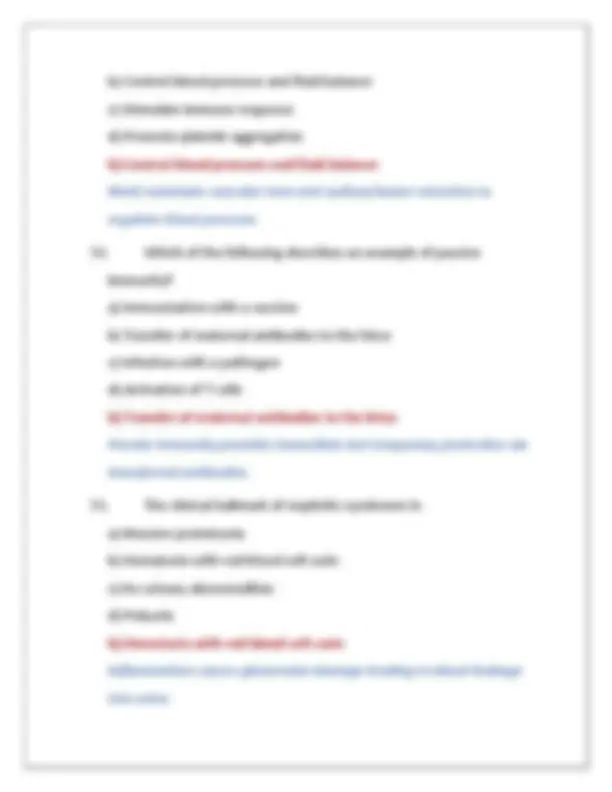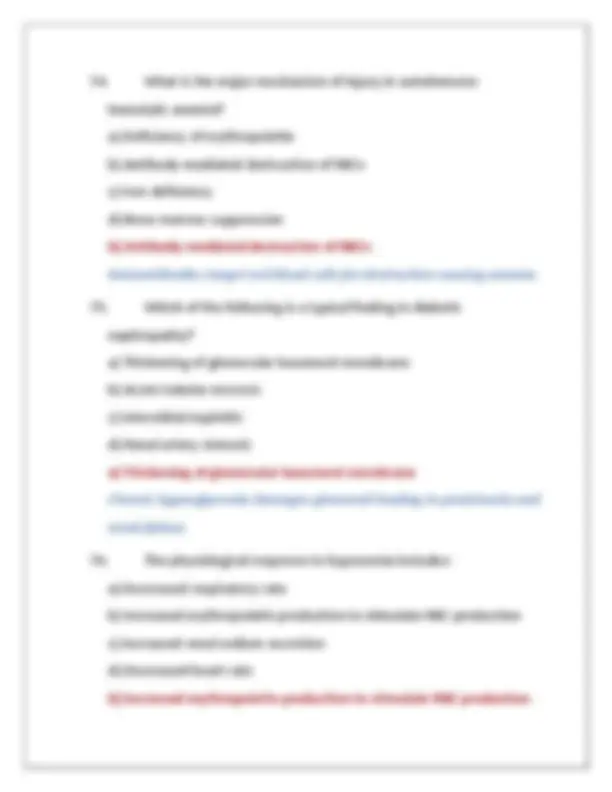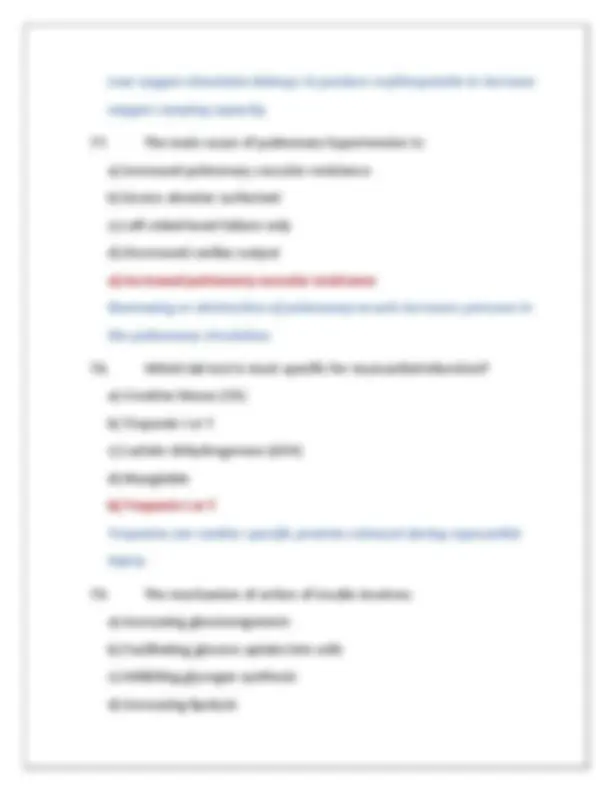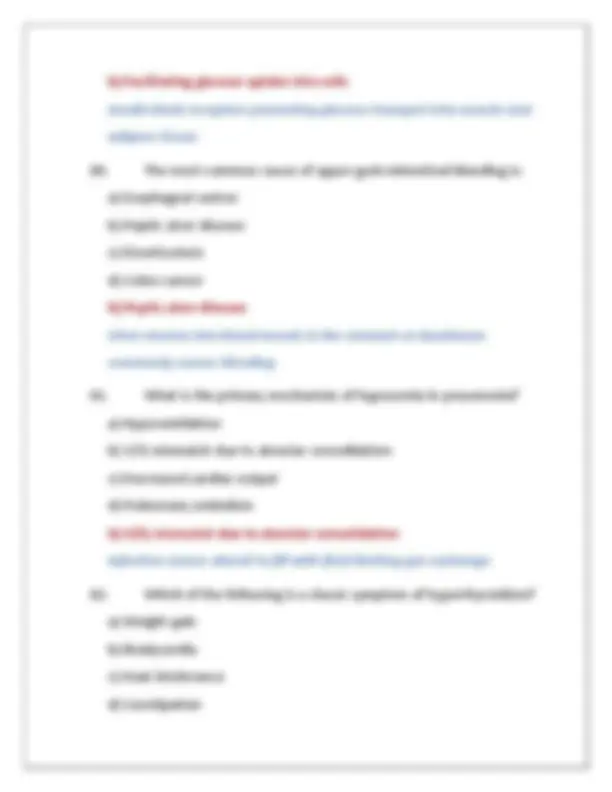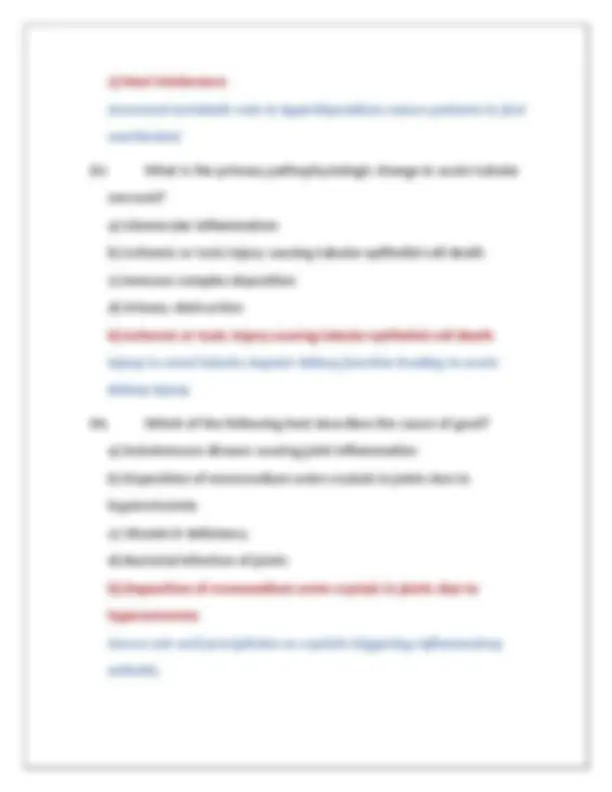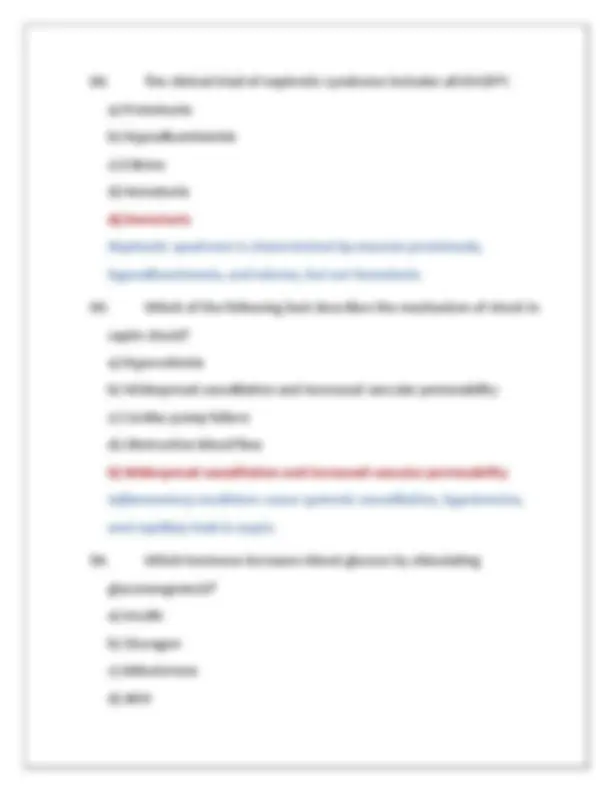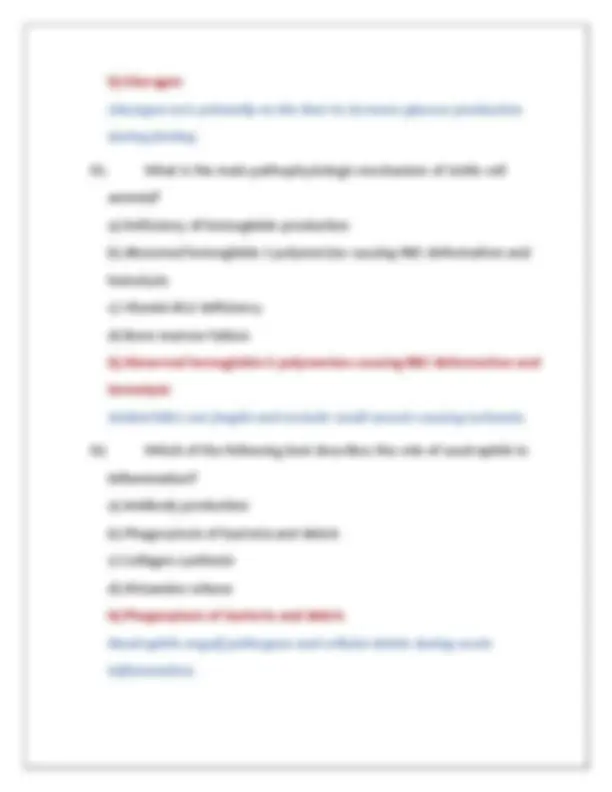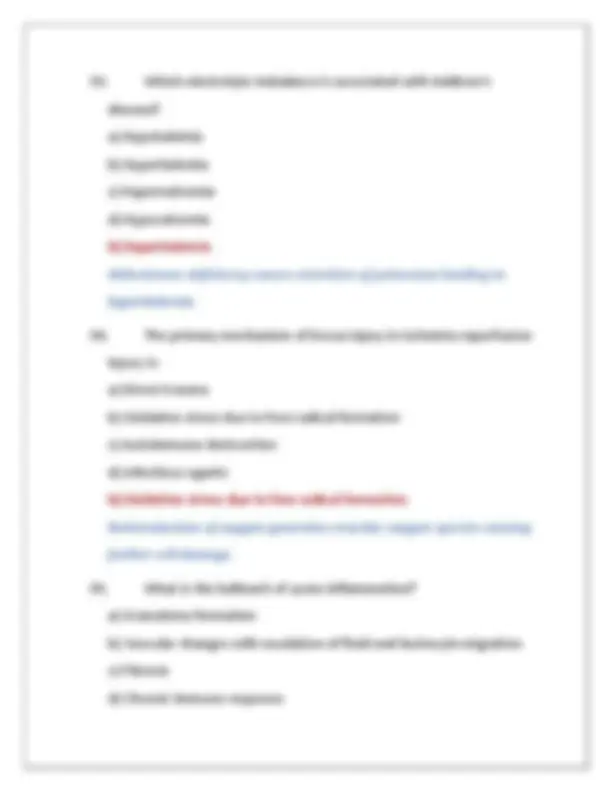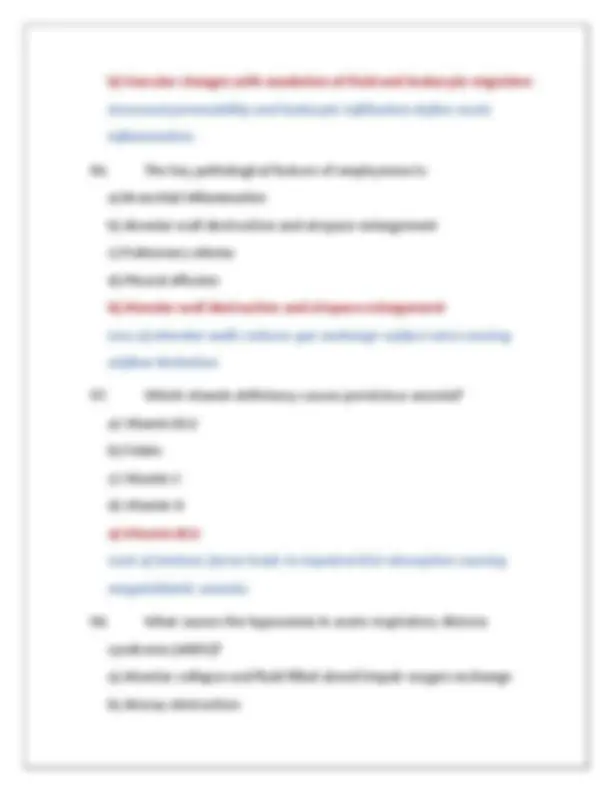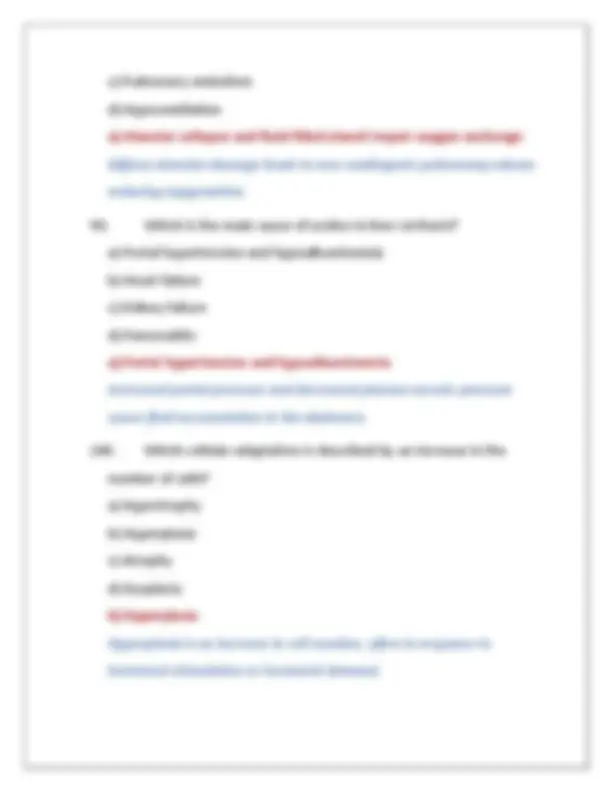Download NSG 5140 Advanced Pathophysiology FINAL Exam Review 2 South College Questions And Correct and more Exams Nursing in PDF only on Docsity!
NSG 5140 Advanced Pathophysiology
FINAL Exam Review 2 South College
Questions And Correct Answers
(Verified Answers) Plus Rationales 2025
Q&A | Instant Download PDF
- Which of the following best describes the primary mechanism of Type 1 Diabetes Mellitus? a) Insulin resistance at the cellular level b) Autoimmune destruction of pancreatic beta cells c) Excessive insulin secretion d) Impaired gluconeogenesis b) Autoimmune destruction of pancreatic beta cells This leads to absolute insulin deficiency causing hyperglycemia characteristic of Type 1 Diabetes.
- The hallmark of acute inflammation is the presence of: a) Fibrosis b) Granuloma formation c) Neutrophil infiltration d) Lymphocyte predominance c) Neutrophil infiltration Neutrophils are the first responders in acute inflammation, migrating rapidly to the site of injury.
- In chronic obstructive pulmonary disease (COPD), which of the following structural changes is most characteristic? a) Alveolar wall destruction and airspace enlargement b) Excessive mucus production and bronchospasm c) Pleural effusion formation d) Pulmonary embolism a) Alveolar wall destruction and airspace enlargement This describes emphysema, a key component of COPD, leading to decreased surface area for gas exchange.
- What is the primary pathophysiological mechanism behind anemia of chronic disease? a) Iron deficiency due to bleeding b) Impaired iron utilization and sequestration in macrophages c) Hemolysis of red blood cells d) Vitamin B12 deficiency
b) Type II c) Type III d) Type IV c) Type III Immune complexes deposit in joints triggering inflammation and tissue damage characteristic of rheumatoid arthritis.
- Which hormone is primarily responsible for the increased insulin resistance seen during pregnancy? a) Progesterone b) Estrogen c) Human placental lactogen (hPL) d) Cortisol c) Human placental lactogen (hPL) hPL antagonizes insulin action to ensure adequate glucose supply for the fetus, increasing insulin resistance.
- In chronic kidney disease, what causes the anemia commonly observed? a) Hemorrhage due to uremia b) Decreased erythropoietin production c) Iron overload d) Hemolysis b) Decreased erythropoietin production
The failing kidneys produce less erythropoietin, leading to decreased RBC production and anemia.
- Which cellular adaptation is characterized by an increase in cell size? a) Hyperplasia b) Hypertrophy c) Metaplasia d) Dysplasia b) Hypertrophy Hypertrophy refers to increased cell size often seen in cardiac muscle with increased workload.
- The release of histamine from mast cells primarily causes: a) Vasoconstriction and decreased permeability b) Vasodilation and increased vascular permeability c) Neutrophil apoptosis d) Increased blood viscosity b) Vasodilation and increased vascular permeability Histamine causes blood vessels to dilate and become more permeable to facilitate immune cell migration.
- What is the primary cause of a myocardial infarction? a) Coronary artery vasospasm b) Thrombotic occlusion of a coronary artery c) Viral myocarditis
b) Increased hydrostatic pressure in pulmonary capillaries c) Decreased lymphatic drainage d) Increased surfactant production b) Increased hydrostatic pressure in pulmonary capillaries Left ventricular failure causes blood to back up into the lungs, increasing capillary pressure and fluid leakage.
- Which cytokine is most responsible for fever during systemic inflammation? a) Interleukin-1 (IL-1) b) Tumor necrosis factor-alpha (TNF-α) c) Interferon-gamma (IFN-γ) d) Interleukin- 10 (IL-10) a) Interleukin-1 (IL-1) IL-1 acts on the hypothalamus to increase body temperature during fever response.
- Which vitamin deficiency causes scurvy? a) Vitamin A b) Vitamin B c) Vitamin C d) Vitamin D c) Vitamin C Vitamin C deficiency impairs collagen synthesis leading to defective connective tissue and bleeding gums.
- In sepsis, the systemic inflammatory response often leads to: a) Decreased cardiac output b) Widespread vasodilation and hypotension c) Hypercoagulability with thrombosis d) All of the above d) All of the above Sepsis causes vasodilation, capillary leak, decreased cardiac output, and coagulopathy leading to organ dysfunction.
- What is the effect of aldosterone on the kidney? a) Increases sodium reabsorption and potassium excretion b) Increases potassium reabsorption and sodium excretion c) Decreases water reabsorption d) Promotes diuresis a) Increases sodium reabsorption and potassium excretion Aldosterone acts on distal tubules to conserve sodium and excrete potassium to regulate fluid balance.
- Which type of necrosis is typically seen in ischemic injury to the brain? a) Coagulative necrosis b) Liquefactive necrosis c) Caseous necrosis d) Fat necrosis b) Liquefactive necrosis
c) Hyperventilation d) Increased renal acid excretion b) Accumulation of ketoacids from fat metabolism Insulin deficiency causes fat breakdown producing acidic ketone bodies, lowering blood pH.
- Which immune cells are primarily involved in type IV hypersensitivity reactions? a) B lymphocytes b) Neutrophils c) T lymphocytes d) Mast cells c) T lymphocytes Type IV hypersensitivity is a delayed-type reaction mediated by sensitized T cells.
- The main pathophysiologic change in Graves’ disease is: a) Autoimmune destruction of thyroid tissue b) Antibody stimulation of the TSH receptor c) Iodine deficiency d) Thyroid hormone resistance b) Antibody stimulation of the TSH receptor Autoantibodies mimic TSH causing hyperthyroidism in Graves’ disease.
- What is the most common cause of hypercalcemia? a) Hyperparathyroidism b) Vitamin D deficiency c) Renal failure d) Hypoparathyroidism a) Hyperparathyroidism Excess PTH causes increased bone resorption and calcium release into the bloodstream.
- The process of fibrosis involves: a) Increased apoptosis of fibroblasts b) Excessive collagen deposition by fibroblasts c) Breakdown of extracellular matrix d) Increased angiogenesis only b) Excessive collagen deposition by fibroblasts Fibrosis is characterized by overproduction of collagen leading to tissue scarring.
- What is the role of surfactant in the lungs? a) Increase surface tension in alveoli b) Prevent alveolar collapse by reducing surface tension c) Facilitate gas exchange by increasing blood flow d) Stimulate mucus secretion b) Prevent alveolar collapse by reducing surface tension
c) Immune complex formation limited to kidneys only d) Primarily a cell-mediated autoimmune disease a) Autoantibodies against DNA and other nuclear components SLE is characterized by widespread autoantibody production targeting nuclear antigens.
- The clinical manifestations of hypokalemia include: a) Muscle weakness and arrhythmias b) Hyperactive reflexes c) Bradycardia d) Hypertension a) Muscle weakness and arrhythmias Low potassium affects muscle and cardiac cell membrane excitability, leading to weakness and irregular heartbeats.
- What is the major cause of portal hypertension in cirrhosis? a) Increased blood flow into the portal vein b) Fibrotic obstruction of portal venous blood flow c) Increased hepatic artery flow d) Splenic vein thrombosis b) Fibrotic obstruction of portal venous blood flow Scar tissue from cirrhosis increases resistance to portal blood flow causing portal hypertension.
- The hallmark of nephrotic syndrome is: a) Hematuria
b) Massive proteinuria c) Decreased glomerular filtration rate d) Urinary tract infection b) Massive proteinuria Damage to the glomerular filtration barrier causes leakage of large amounts of protein in urine.
- Which of the following best explains edema formation in nephrotic syndrome? a) Decreased plasma oncotic pressure due to protein loss b) Increased capillary hydrostatic pressure c) Lymphatic obstruction d) Decreased sodium retention a) Decreased plasma oncotic pressure due to protein loss Loss of albumin lowers plasma oncotic pressure causing fluid to leak into interstitial spaces.
- The primary pathological process in atherosclerosis involves: a) Vasculitis and inflammation b) Endothelial injury and lipid deposition c) Vasospasm d) Autoimmune destruction of vessel walls b) Endothelial injury and lipid deposition Endothelial damage allows lipids to accumulate in vessel walls triggering inflammation and plaque formation.
a) Elevated serum amylase and lipase Pancreatic inflammation causes release of digestive enzymes into the bloodstream.
- The pathophysiology of asthma primarily involves: a) Irreversible airway remodeling b) Chronic bacterial infection of the airways c) Airway inflammation, bronchoconstriction, and hyperresponsiveness d) Alveolar destruction c) Airway inflammation, bronchoconstriction, and hyperresponsiveness Asthma is characterized by episodic airway narrowing due to inflammation and smooth muscle contraction.
- What is the key electrolyte disturbance in diabetic ketoacidosis after treatment begins? a) Hyperkalemia b) Hypokalemia c) Hypernatremia d) Hypocalcemia b) Hypokalemia Insulin treatment drives potassium into cells causing a drop in serum potassium despite initial hyperkalemia.
- Which of the following best explains the cause of jaundice in hemolytic anemia? a) Increased conjugation of bilirubin in the liver b) Increased production of unconjugated bilirubin from RBC breakdown c) Decreased bile production d) Obstruction of bile ducts b) Increased production of unconjugated bilirubin from RBC breakdown Excess hemolysis overwhelms liver conjugation capacity causing elevated unconjugated bilirubin and jaundice.
- The main cause of acute respiratory distress syndrome (ARDS) is: a) Cardiogenic pulmonary edema b) Diffuse alveolar damage and increased capillary permeability c) Chronic bronchitis d) Pleural effusion b) Diffuse alveolar damage and increased capillary permeability ARDS results from inflammatory injury to alveolar-capillary membranes causing non-cardiogenic edema and hypoxia.
- The pathophysiology of Hashimoto’s thyroiditis involves: a) Antibody-mediated stimulation of thyroid hormone production b) Autoimmune destruction of thyroid tissue c) Iodine excess
- The pathophysiologic hallmark of acute tubular necrosis (ATN) is: a) Glomerular inflammation b) Tubular epithelial cell injury and necrosis c) Interstitial fibrosis d) Immune complex deposition b) Tubular epithelial cell injury and necrosis Ischemic or nephrotoxic injury damages renal tubules causing impaired filtration and renal failure.
- Which of the following conditions is characterized by hyperuricemia and deposition of urate crystals in joints? a) Osteoarthritis b) Rheumatoid arthritis c) Gout d) Lupus c) Gout Gout is caused by purine metabolism disorder leading to uric acid crystal formation and acute arthritis.
- In the context of heart failure, BNP (brain natriuretic peptide) levels: a) Decrease due to reduced cardiac output b) Increase due to ventricular stretch c) Remain unchanged d) Increase due to renal failure only
b) Increase due to ventricular stretch BNP is secreted by stretched ventricles and serves as a marker for heart failure severity.
- Which of the following best explains the cause of metabolic alkalosis? a) Excess acid production b) Loss of hydrogen ions or gain of bicarbonate c) Accumulation of lactic acid d) Decreased renal bicarbonate reabsorption b) Loss of hydrogen ions or gain of bicarbonate Metabolic alkalosis occurs due to excessive loss of acid (e.g., vomiting) or increased bicarbonate retention.
- What is the main pathological feature of chronic gastritis caused by Helicobacter pylori? a) Autoimmune destruction of parietal cells b) Chronic inflammation with mucosal atrophy and intestinal metaplasia c) Acute neutrophilic infiltration d) Ulcer formation only b) Chronic inflammation with mucosal atrophy and intestinal metaplasia

